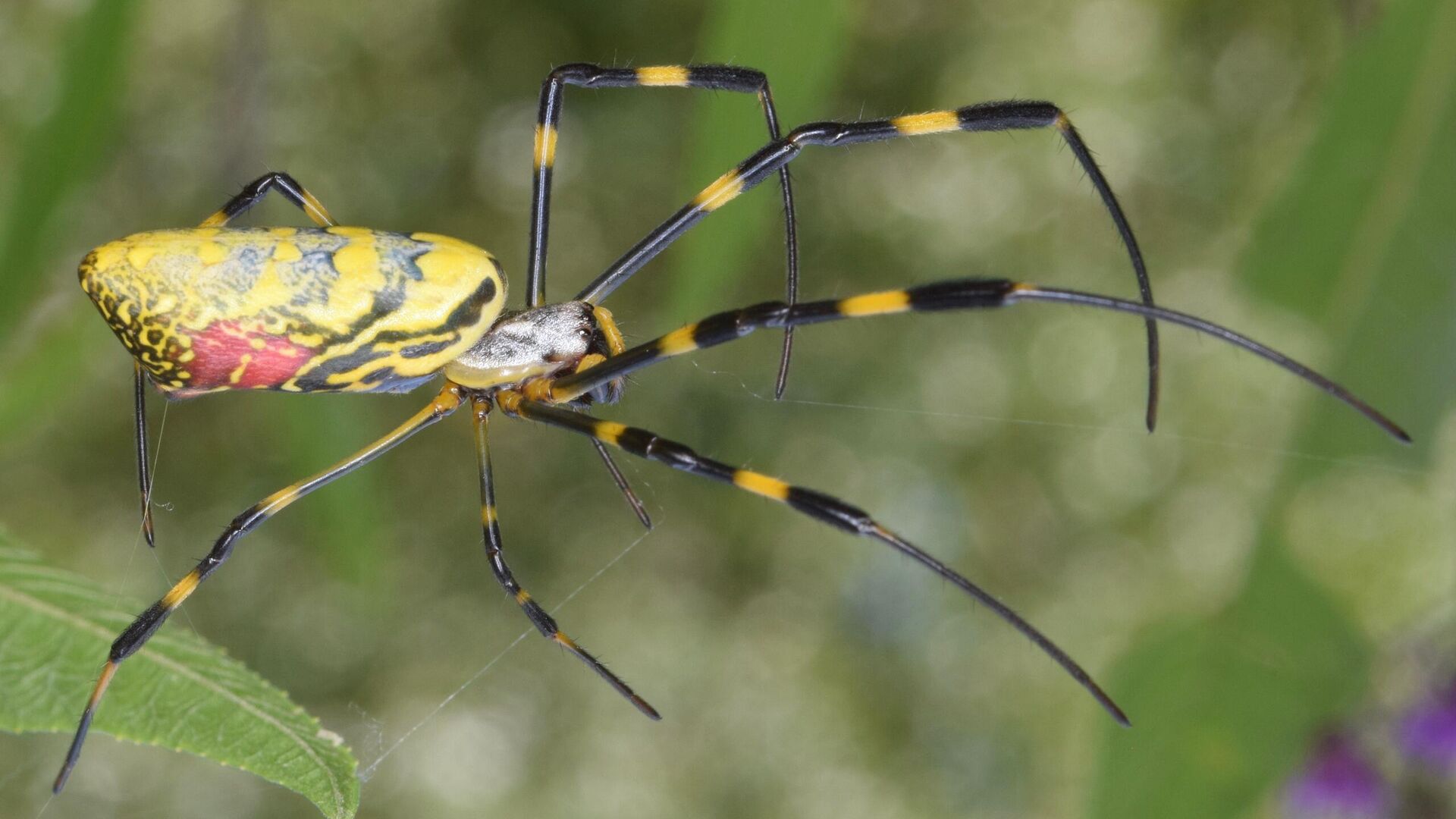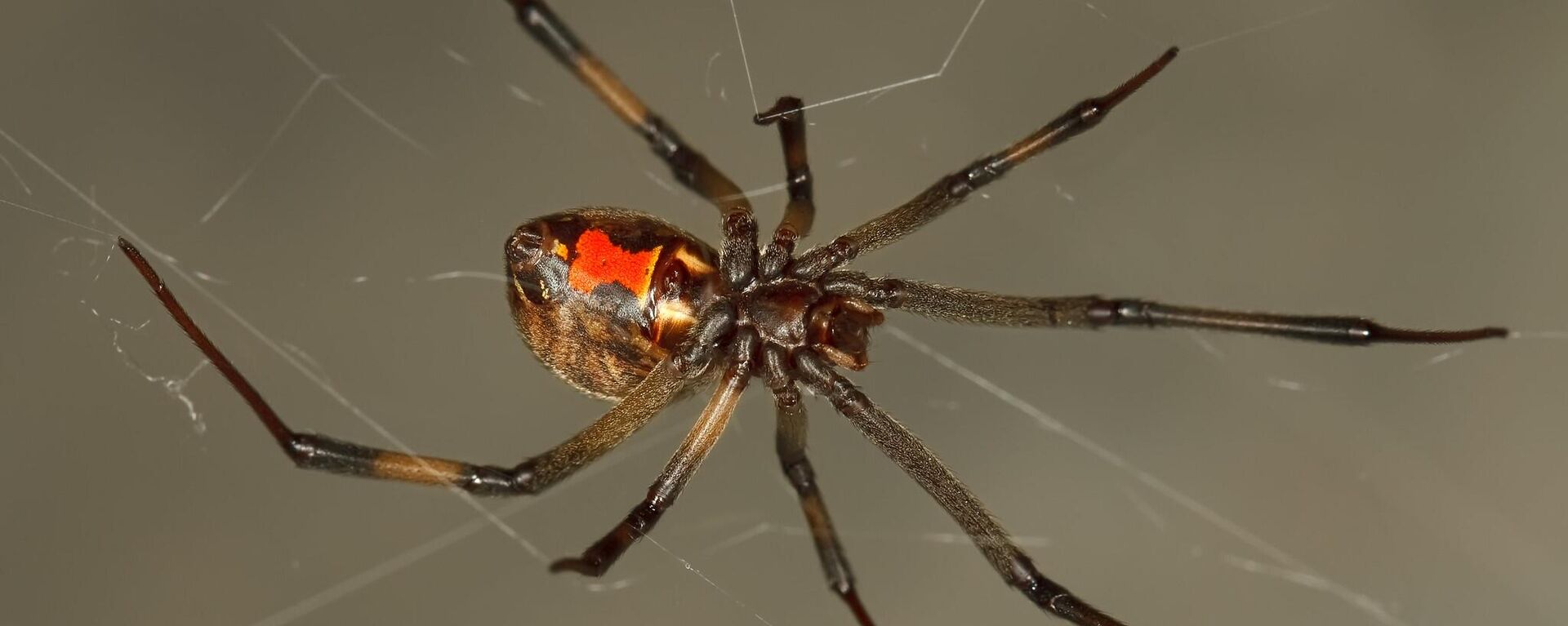https://sputnikglobe.com/20231104/joro-spider-spread-ensnares-southeastern-us-states-study-reveals-1114722790.html
Joro Spider Spread Ensnares Southeastern US States, Study Reveals
Joro Spider Spread Ensnares Southeastern US States, Study Reveals
Sputnik International
Entomologists have identified spider species originating from East Asia rapidly spreading in the US' southeast. Scientists believe they have come to stay.
2023-11-04T18:28+0000
2023-11-04T18:28+0000
2023-11-04T18:29+0000
beyond politics
science & tech
society
newsfeed
georgia
south carolina
clemson university
https://cdn1.img.sputnikglobe.com/img/07e7/0b/04/1114722993_0:305:2560:1745_1920x0_80_0_0_1425120a4f95afd2f342072ab3b15d2d.jpg
Researchers have recently identified a new species of spider in the United States characterized by its considerable size and vivid coloration. These arachnids employ a form of locomotion known as "ballooning" and are expanding their presence across various states, per recent findings.Clemson University researchers have documented the swift territorial expansion of the Joro spider, now moving past South Carolina, with a trajectory aimed at overtaking much of the eastern United States. Professor David Coyle, associated with the research, has confirmed the spiders' establishment as a permanent inhabitant of the ecosystem where they are found.In a Clemson University release, Coyle sheds light on the adaptive range of the Joro spider. Leveraging 20 sophisticated predictive models, the research anticipates the spider’s potential to spread across the Eastern United States, aligning with the spider's native environmental conditions.Understanding the Joro spider involves exploring its origins, habitat, and the possible danger it may present to people.What is a Joro Spider?Joro spiders, recognized scientifically as Trichonephila clavata, exhibit notable sexual differences. Researchers observe that the females boast a sizeable 3-4 inch body with a bright yellow and blue striped appearance, complemented by a red abdomen. In stark contrast, the males are pretty petite, rarely growing more than a quarter-inch, and sport a brown color with patterns of dark gray, black, and yellow.Scientists at the University of Georgia categorize the species as golden orb-web weavers, noting their preference for the outdoors and their specialized silk-weaving skills, which result in large, golden-tinted webs.What is the Origin of Joro Spiders?Since arriving in Hoschton, Georgia, in 2013, the Joro spider, hailing from regions such as Japan, Korea, Taiwan, and China, has established itself across a swath of the southeastern United States.A recent update from Clemson University confirms its presence in regions stretching over 120,000 square kilometers, with its web now cast through multiple states beyond Georgia, including the Carolinas, Tennessee, and sporadically as far as Alabama, Maryland, Oklahoma, and West Virginia. The Joro has shown remarkable adaptability, thriving in diverse locales ranging from natural woodlands to suburban zones.Do Joro Spiders Pose a Danger to Humans and Pests?Entomologist Nancy Hinkle informed news outlets that the Joro spider, while venomous, poses no real threat to humans or household pets, as bites are infrequent and ineffective. Hinkle also highlighted the spiders' role in natural pest management, feasting on flies, stink bugs, mosquitoes, etc., and being part of the avian diet, with their ecological impact on the US’s southeastern ecosystem is still under investigation.What is the Developmental Cycle of the Joro Spider?In the temperate zones they inhabit, Joro spiders have a natural lifespan that generally caps at 12 months. When the fall season sets in, female Joros enter their reproductive phase, diligently producing up to five egg sacs stretching from September to November. These sacs, often affixed to artificial edifices, foliage, or the outer layer of trees, are brimming with many future offspring, generally tallying between 400 and 500 eggs.The hatching of spiderlings occurs within a window of five to seven months after laying. Upon hatching, they band together to form a communal silk structure, undergo the shedding of their exoskeletons, and ultimately part ways through the ballooning method to venture into new environments. A high mortality rate marks this critical phase as many spiderlings never reach adulthood, owing to being preyed upon by their nest-mates.The journey to adulthood for female Joro spiders spans three to five months, outpaced by the earlier maturing males. Adults of both sexes are known to inhabit a communal web, where they are often accompanied by kleptoparasites—opportunistic thieves that feast on the spiders' captured nourishment. All adult Joro's die during winter.
https://sputnikglobe.com/20230321/they-dont-play-well-black-widow-spiders-being-deliberately-killed-off-by-invasive-cousins-1108621006.html
https://sputnikglobe.com/20220426/male-spiders-learn-how-to-eject-themselves-to-escape-sexual-cannibalism-study-finds-1095077463.html
georgia
south carolina
Sputnik International
feedback@sputniknews.com
+74956456601
MIA „Rossiya Segodnya“
2023
Chimauchem Nwosu
https://cdn1.img.sputnikglobe.com/img/07e7/09/01/1113046371_0:99:1536:1635_100x100_80_0_0_9c5c627283eca931c39fe4852bbb301c.jpg
Chimauchem Nwosu
https://cdn1.img.sputnikglobe.com/img/07e7/09/01/1113046371_0:99:1536:1635_100x100_80_0_0_9c5c627283eca931c39fe4852bbb301c.jpg
News
en_EN
Sputnik International
feedback@sputniknews.com
+74956456601
MIA „Rossiya Segodnya“
Sputnik International
feedback@sputniknews.com
+74956456601
MIA „Rossiya Segodnya“
Chimauchem Nwosu
https://cdn1.img.sputnikglobe.com/img/07e7/09/01/1113046371_0:99:1536:1635_100x100_80_0_0_9c5c627283eca931c39fe4852bbb301c.jpg
joro spider, trichonephila clavata, ballooning, clemson university, david coyle, arachnid, sexual dimorphism, golden orb-web weavers, joro spider united states expansion, nancy hinkle, joro spider natural pest management, joro spider ecological impact, joro spider reproductive phase, joro spider egg sacs, joro spider ballooning dispersal.
joro spider, trichonephila clavata, ballooning, clemson university, david coyle, arachnid, sexual dimorphism, golden orb-web weavers, joro spider united states expansion, nancy hinkle, joro spider natural pest management, joro spider ecological impact, joro spider reproductive phase, joro spider egg sacs, joro spider ballooning dispersal.
Joro Spider Spread Ensnares Southeastern US States, Study Reveals
18:28 GMT 04.11.2023 (Updated: 18:29 GMT 04.11.2023) Entomologists have identified spider species originating from East Asia rapidly spreading in the US' southeast. Scientists believe they have come to stay.
Researchers have recently identified a new species of spider in the United States characterized by its considerable size and vivid coloration. These arachnids employ a form of locomotion known as "ballooning" and are expanding their presence across various states, per recent findings.
The ballooning method is a dispersal strategy used by some species of spiders, particularly young spiderlings. This process allows them to travel great distances — even hundreds of kilometers — and colonize new areas far from their birthplace.
Clemson University researchers have documented the swift territorial expansion of the Joro spider, now moving past South Carolina, with a trajectory aimed at overtaking much of the eastern United States. Professor David Coyle, associated with the research, has confirmed the spiders' establishment as a permanent inhabitant of the ecosystem where they are found.
An arachnid is a member of the class Arachnida, a group within the larger phylum of Arthropoda. Arachnids are characterized by having eight legs and a body divided into two segments: the cephalothorax (or prosoma) and the abdomen (or opisthosoma). Unlike insects, they do not have antennae or wings.
Spiders, the largest order within this class, are distinguished by their ability to produce silk from spinnerets at the rear of their abdomen. This trait is employed for various purposes, like creating webs for catching prey, lining burrows, and making egg sacs.
In a Clemson University release, Coyle sheds light on the adaptive range of the Joro spider. Leveraging 20 sophisticated predictive models, the research anticipates the spider’s potential to spread across the Eastern United States, aligning with the spider's native environmental conditions.
Understanding the Joro spider involves exploring its origins, habitat, and the possible danger it may present to people.
Joro spiders, recognized scientifically as Trichonephila clavata, exhibit notable sexual differences. Researchers observe that the females boast a sizeable 3-4 inch body with a bright yellow and blue striped appearance, complemented by a red abdomen. In stark contrast, the males are pretty petite, rarely growing more than a quarter-inch, and sport a brown color with patterns of dark gray, black, and yellow.
Scientists at the University of Georgia categorize the species as golden orb-web weavers, noting their preference for the outdoors and their specialized silk-weaving skills, which result in large, golden-tinted webs.
What is the Origin of Joro Spiders?
Since arriving in Hoschton, Georgia, in 2013, the Joro spider, hailing from regions such as Japan, Korea, Taiwan, and China, has established itself across a swath of the southeastern United States.
A recent update from Clemson University confirms its presence in regions stretching over 120,000 square kilometers, with its web now cast through multiple states beyond Georgia, including the Carolinas, Tennessee, and sporadically as far as Alabama, Maryland, Oklahoma, and West Virginia. The Joro has shown remarkable adaptability, thriving in diverse locales ranging from natural woodlands to suburban zones.
Do Joro Spiders Pose a Danger to Humans and Pests?
Entomologist Nancy Hinkle informed news outlets that the Joro spider, while venomous, poses no real threat to humans or household pets, as bites are infrequent and ineffective. Hinkle also highlighted the spiders' role in natural pest management, feasting on flies, stink bugs, mosquitoes, etc., and being part of the avian diet, with their ecological impact on the US’s southeastern ecosystem is still under investigation.
What is the Developmental Cycle of the Joro Spider?
In the temperate zones they inhabit, Joro spiders have a natural lifespan that generally caps at 12 months. When the fall season sets in, female Joros enter their reproductive phase, diligently producing up to five egg sacs stretching from September to November. These sacs, often affixed to artificial edifices, foliage, or the outer layer of trees, are brimming with many future offspring, generally tallying between 400 and 500 eggs.
The hatching of spiderlings occurs within a window of five to seven months after laying. Upon hatching, they band together to form a communal silk structure, undergo the shedding of their exoskeletons, and ultimately part ways through the ballooning method to venture into new environments. A high mortality rate marks this critical phase as many spiderlings never reach adulthood, owing to being preyed upon by their nest-mates.
An exoskeleton is a rigid or semi-rigid structure that protects against physical trauma and desiccation.
The journey to adulthood for female Joro spiders spans three to five months, outpaced by the earlier maturing males. Adults of both sexes are known to inhabit a communal web, where they are often accompanied by kleptoparasites—opportunistic thieves that feast on the spiders' captured nourishment. All adult Joro's die during winter.





